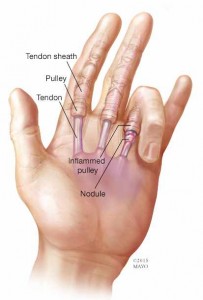-
Weekend Wellness: In many cases, trigger finger can be safely and effectively corrected
DEAR MAYO CLINIC: My index finger is often stiff and sometimes makes a clicking sound when I move it. It even sometimes gets “stuck.” My doctor told me I have trigger finger and that I should rest it for a few weeks to see if it improves, but that’s been hard to do since I work with my hands. Are there any other treatment options I could try?
It even sometimes gets “stuck.” My doctor told me I have trigger finger and that I should rest it for a few weeks to see if it improves, but that’s been hard to do since I work with my hands. Are there any other treatment options I could try?
ANSWER: Trigger finger happens as a result of inflammation and irritation around a finger tendon. Therapies such as rest, applying ice or heat, and splinting the finger usually are the first steps in treatment. But other options are available, including steroid injections and surgery.
Your tendons are like ropes that connect muscle to bone. Each tendon within your hand is surrounded by natural thickenings, called pulleys, which allow your fingers to move easily. Trigger finger develops when a pulley that lies underneath your knuckle becomes irritated and inflamed. This interferes with the normal gliding motion of the tendon through the pulleys in your hand.
Symptoms of trigger finger typically involve the ones you mention — stiffness, a popping or clicking sensation when the finger moves, and the finger becoming locked in a bent position. Other symptoms can include pain, tenderness, and a bump (nodule) at the base of the finger.
If symptoms are not severe and do not interfere with your daily activities, home remedies may be enough to correct the problem. Resting the finger by avoiding activities involving repetitive gripping or repeated grasping can be useful. Wearing a temporary splint at night to keep the finger extended while you sleep can help rest the tendon. Putting ice on your palm several times a day or soaking your hand in warm water may ease symptoms, too.
If these steps are not enough or if, as in your situation, resting the finger is not an option due to work or other daily activities, ask your doctor about getting a steroid injection.
A steroid medication may reduce inflammation and allow the tendon to glide freely again. This treatment can offer long-term relief. It works best for those who have only one finger affected and who have had symptoms for less than three months. It tends to be less effective in people with diabetes.
If an injection provides relief for several months or more and symptoms return, another injection may be useful. If, however, you do not get symptom relief from a steroid injection, or if symptoms return within a few days to a few weeks following an injection, you may need surgery.
Surgery for trigger finger is usually brief and does not require a hospital stay. Working through a small incision near the base of the finger, a surgeon can cut open the constricted section of the pulley that causes trigger finger, known as the A1 pulley. Releasing the pulley allows the tendon to move freely.
A newer and less-invasive technique involves using a sturdy needle to cut the pulley and release the catch around your tendon. Moving the needle and the affected finger helps break apart the constriction blocking the smooth motion of the tendon. Doctors typically use ultrasound images during this treatment to see where the tip of the needle is under the skin.
Possible side effects of both surgical approaches include damage to blood vessels and nerves. There is also a small risk of a condition developing after these procedures called bow-stringing, in which the tendon separates from the bone due to other pulleys being released. That can make it hard to fully extend your finger and may affect your ability to use your finger.
Talk to your doctor about additional treatments for trigger finger beyond just resting it. In many cases, this condition can be safely and effectively corrected. — Sanjeev Kakar, M.D., Orthopedic Surgery, Mayo Clinic, Rochester, Minn.
Related Articles







